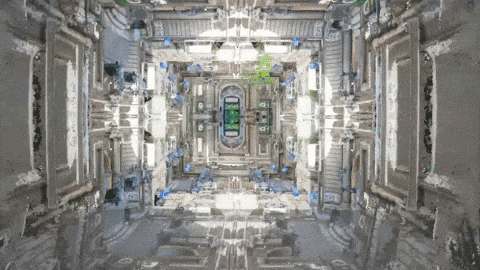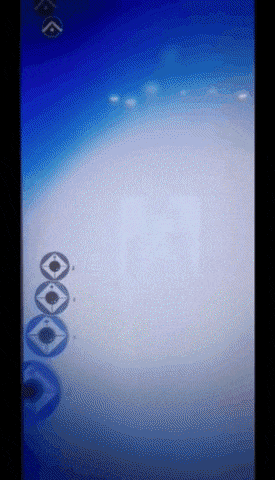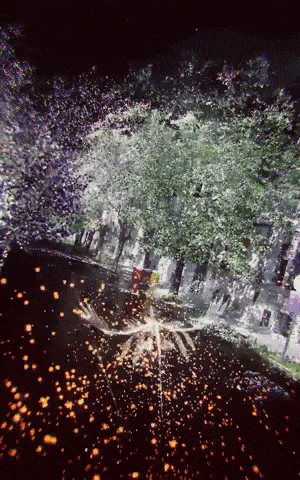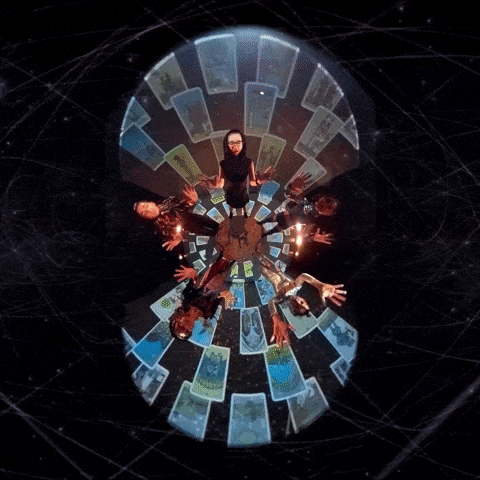Interview Simona Serban


Taking reality and the present moment, transferring it to other dimensions and getting the best experience out of it – that is the ASA experience in a nutshell. Augmented Space Agency, in its long description, is an incredible multilateral research and implementation studio that plays and works with your mind and imagination. I came across ASA a few years back, and I was extremely impressed with the amount of passion, knowledge and openness they showcased when interacting with people and their projects. Everything is interconnected, and they definitely take that into consideration.
FLIGHT FACILITY, a project developed by Augmented Space Agency and fonduri-structurale.ro, in partnership with CINETic and B&B 3D scanning, is an art & technology conceptual space designed for Flight Festival 2019. The central project, alongside the interactive gamified experience design, encourages us to connect to both the past and the future architectural legacy of Timișoara, Romania, transcending and getting intertwined within its complex history.
As a fellow architect, I have always asked myself what’s the next step in presenting my projects and what other mediums I can use to make my architectural models jump off the page and make themselves better understood. I like to believe a lot of architects, designers and creatives have also asked themselves that; ASA definitely asked themselves that question and, more importantly, acted on it as their main goal is, in their own words, ‘to establish a creative outlet that validates AR/VR/MR as a creative medium whilst provoking research and discussion opportunities’. In their vision, the future is AR/VR/MR.
Another interesting example of following your passion and combining it with your craftsmanship is the result of ASA’s ROMACEN project in Sfântul Gheorghe, Romania. A virtual scenography, experimenting with immersive and interactive technologies as tools of trade, their involvement in the project resulted in a mixed reality theatre scenography so vivid that it makes you wonder if you really just walked in on a witchy spell-casting session. The scenography of ROMACEN, in their own words, was a compilation ‘of the physical presence of the six techno-witches with the dreamlike virtual space aiming to enforce the futurist and feminist dramatic structure’.
Besides creating incredible world-transcending, stand-alone installations and projects, ASA makes time to create interactive workshops for students and lovers of virtual worlds, transferring their knowledge to them and creating a sense of AR community. With a declared vision of overcoming barriers between physical and virtual dimensions, it is no wonder that this passion translates into their work so perfectly.
What we could learn from ASA, you will discover in their interview, is that multidisciplinary is key for creativity, continuous unique design approaches and our right passion. It is also interesting to point out the integrated diverse skill sets of the ASA members; maybe this could be the secret key ingredient for success, having a very diverse team; find yourself passionate people, each with their quirks and unique skills and go change the world.
Their latest project, DREAM SPACE MECHANICS, embodied in Bucharest, Romania, is a spatial three-dimensional audiovisual composition in augmented reality. This experiment endeavours into the unexplored realm of augmented reality, where spatially volumetric sounds and surreal objects are devised in order to offer a mesmerizing experience. Thus, in doing so, the viewer can experience the installation through a state-of-the-art mobile AR app available for free on App Store and Play Store.
In DREAM SPACE MECHANICS, the objective reality is presented as a dream state; there is no one single reality, just relative intersections of spacetime dimensions, gravitational fields and relative motions, transdimensional entities and infinite perspectives, timeless echo waves and immaterial holographic projections. An interwoven multidimensional mechanism, a spacetime experience where dreams are projections of a transdimensional existence.
When it comes in contact with the digital arts, AR, VR, MR, immersive visuals and interactive new media expressions, the human mind tends to stop and think, as regardless of the topic of the artistic installations, it can’t put a label on it immediately – so a silence sets in, kind of like the one around a Black Hole; if done correctly, this type of immersive art can generate powerful emotions, tugging at the viewers’ senses. I can’t begin to imagine what happens in the mind of those that conceptualize and create them in the first place.



For those that are not familiar with the studio’s practice, could you tell us more about what made you start the Augmented Space Agency? What was the sequence that led to the launch of ASA?
At first, I think it was the fascination and curiosity to explore new technologies that can generate innovation in fields close to our interests, digital visual arts, design and architecture. From a personal perspective, my definitive decision to give up my former professional path, architectural design, added a kind of pressure to find a new professional career, and my mind was always set on the future creative fields.
Yet this journey was a collective endeavour, where a group of close friends with similar hobbies and interests started to play around with new technologies and generate new creative ideas. With this mindset plus a few years of playing around, research, learning, trials and errors, our attention converged towards the concepts of augmented reality and other related technologies that were starting to become accessible to us.
This was around 2015 when together with my friends and architecture university colleagues, Sabin and Andrei, we started a more systematic research and experimentation process. We already had a rich experience in computer graphics, procedural design, some programming skills and, of course, architectural education played out to be a very important factor. So we ended up testing almost every augmented reality development pipeline and solution available at that moment until we decided that a game engine is the most powerful solution.
Our research was also looking for new opportunities to express and share our knowledge with the world, following my previous experience as a workshop tutor and the newly launched call by European Architecture Student Assembly to organise a workshop in Valletta, Malta. This was the moment when the identity of our group was born; we applied as Augmented Space Agency, proposing an experimental AR workshop; this event marked the foundation of our studio.
What would you say is the key characteristic or characteristics a project has to have initially for you to want to get involved in it?
Ideally, a project needs to resonate in one way or another with our vision, a vision driven by the spirit of exploration and with the mission to design novel experiences infused with creative and innovative technologies. Yet an interesting challenge can offer the right motivation as long the given problem can be solved using digitally augmented, immersive and interactive technologies. Not least, we also need to take care of the financial stability of the studio; in this context, a project needs to generate a direct or indirect income to sustain our activity.
The ASA crew members have influences from multiple creative industries, such as architecture, design, digital arts, creative coding & game development. How does that come into play when brainstorming for a new project?
I think diversity is essential in any creative practice, especially in complex projects that need a diverse skill set to be implemented. Given both technical and creative challenges faced by many of our projects during the ideation process, we heavily rely on all of these influences to define not only a clear direction but also a powerful one able to play both artistry and technical finesse. Our approach is using an iterative design where the brainstorming phase is integrated into a cyclical process and often supplemented by rounds of internal and external feedback.
More so, following our space exploration mission towards the vast space of the reality-virtuality continuum, we are constantly striving to expand our knowledge and influences either by learning or growing our team. Supported by this mindset, we are constantly expanding our expertise at the same time; we are feeding our curiosity and passion for our work. This is sustained by a methodical approach where each member proposes or chooses a research topic either from a theoretical or applied field. For example, I am researching new media-infused scenographic design for performative arts, while my colleagues Dan and Florin are researching interactive design for eyewear devices, respectively, interactive haptic technologies.
It is visible that you put a lot of time, research and effort into finding new, innovative ways to create integrated experiences with the use of immersive new media mechanisms for the people interacting with your works. This is why when it comes to creative and interactive workshops, ASA is no stranger, judging from the impressive list of past workshops. What drives you to pilot these types of workshops? Do you believe AR (Augmented Reality), MR (Mixed Reality) and VR (Virtual Reality) to be the future tools to achieve seriorial introspection for humanity?
Workshops are an integral part of our activity, and they were essential in the first steps made by our studio. These kinds of initiatives can offer a great experiential and transdisciplinary context where you can both share and learn, a great way to test new ideas in an applied manner, and, more so, meet wonderful peoples that have similar interests and passions. I think workshops can benefit any field; they can have a positive impact on education. They can play an important role in community development, especially when we are talking about new fields like AR and VR.
I think the new media spectrum defined by MR, AR, VR and other related media formats will play a massive role in the future of humanity. More beautifully defined back in ‘94 by Paul Milgram’s virtuality-reality continuum diagram, this dynamic spectrum found in constant evolution can generate more efficient ways of seamlessly integrated communication and also tools/methods of both introspection and outrospection. The dawn of the future languages of communication is here, and for sure, these digitally augmented, immersive and interactive media technologies will contribute greatly to this phenomenon.
Also, I think it is important to see AR, VR and MR in a bigger context where these media technologies are interconnected with outer technologies and domains, for example, AI and IoT. In this super-integrated internet era, we are already witnessing great evolutionary leaps, and it is our mission as humans to make sure that the impact on our planet and society will be a positive one.
Even viewed at a glance, ASA projects have an incredible power to appeal to not only the user’s precious and limited attention but also to make them aware of their immediate surroundings, either real, augmented, virtual or mixed. Your latest project, DREAM SPACE MECHANICS, is one example of a mesmerising project that experiments with the inner spatial boundaries of the viewer’s mind. In your opinion, on the matter, why do these new mediums have such a stronghold on people’s imagination?
A really short answer might be that art is triggering imagination, and imagination is generating art. Because I love to see things from different perspectives continuing with the same context of media technologies evolution, it is obvious that humanity is constantly perfecting and innovating the means of communication. The technology is still far behind compared with the complexity of biological systems. Yet, in the last three decades, it has seen huge improvements by adding to the mix new sensorial channels or interfaces of communication.
The technological goal might be the ability of a medium to address one or more sensory channels. Currently, I think visual and sound are already quite close to being perfect; we still have to deal with kinaesthetic, olfactory and gustatory. Maybe the last two of them won’t be that relevant, but I think the kinaesthetic language of communication will play an important role in the near future of media.
But enough with technology and sensory channels! Of course, they offer the necessary framework to create novel interfaces that only will add to the already diverse archive of stories and experiences created by humanity. From another perspective,, as you mentioned the term, the realm of imagination may have an even more complex story and spatial maze to be explored.
For this reason, our approach might also have art-based research that is searching for new languages of art to question the existing languages of communication. DREAM SPACE MECHANICS is one of those projects that is trying to push the boundaries of artistic expression, exploring how one’s kinaesthetic presence immersed in a mixed reality environment will interact with spatialised audio and visual elements and how this experience will change its sensory and emotional perception of the existing physical space.
It turns out that this kind of experience is triggering imagination, I am not sure if the novelty of the medium is the main trigger, but I like to believe that the artistic or creative vision plays an important role. DREAM SPACE MECHANICS experience is available on our mobile AR app Augmented Space Agency.
What’s next on the horizon for ASA in 2020 and beyond?
Like for many, 2020 was the year for re-adjustments; we put on hold many of our event-related projects, but our initial focus towards mobile technologies is now enforced by the current context. Our next projects are using augmented and mixed reality, together with web-based virtual reality focused on the art and cultural sectors. At the same time, we are continuing the development of our mobile app platforms Augmented Space Agency app, which serves as a research and experimental art gallery focused on immersive AR experiences and we.AR is an eye-candy gallery for image-based AR projects.
Our mission remains the same, to explore the fringes of the mixed reality continuum by experimenting with new artforms, designing synergetic and inspiring experiences and developing innovative new media solutions. To offer our audiences new perspectives both on the world and themselves, for our clients better tools for innovation and grow ourselves as a studio into better human beings.
What is your chief enemy of creativity?
This question brings me back to reality. I think some people’s one-sided views.
You couldn’t live without…
My thirst for knowledge and the ability to create.





